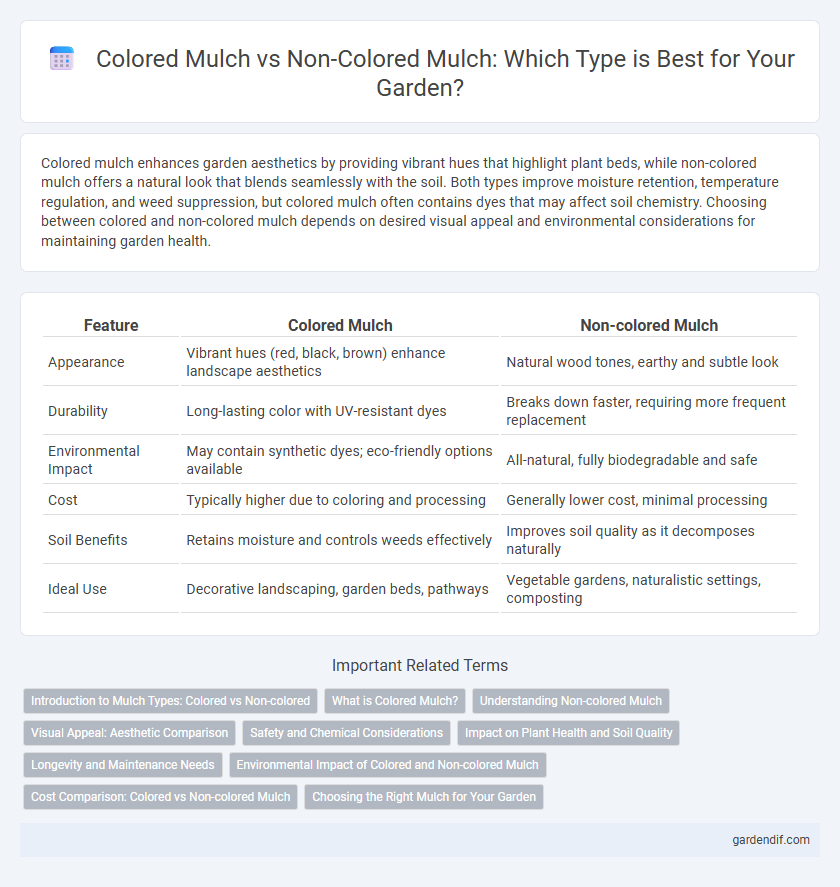
Colored Mulch vs Non-colored Mulch Illustration
Colored mulch enhances garden aesthetics by providing vibrant hues that highlight plant beds, while non-colored mulch offers a natural look that blends seamlessly with the soil. Both types improve moisture retention, temperature regulation, and weed suppression, but colored mulch often contains dyes that may affect soil chemistry. Choosing between colored and non-colored mulch depends on desired visual appeal and environmental considerations for maintaining garden health.
Table of Comparison
| Feature | Colored Mulch | Non-colored Mulch |
|---|---|---|
| Appearance | Vibrant hues (red, black, brown) enhance landscape aesthetics | Natural wood tones, earthy and subtle look |
| Durability | Long-lasting color with UV-resistant dyes | Breaks down faster, requiring more frequent replacement |
| Environmental Impact | May contain synthetic dyes; eco-friendly options available | All-natural, fully biodegradable and safe |
| Cost | Typically higher due to coloring and processing | Generally lower cost, minimal processing |
| Soil Benefits | Retains moisture and controls weeds effectively | Improves soil quality as it decomposes naturally |
| Ideal Use | Decorative landscaping, garden beds, pathways | Vegetable gardens, naturalistic settings, composting |
Introduction to Mulch Types: Colored vs Non-colored
Colored mulch, typically made from natural wood dyed with safe pigments, enhances landscape aesthetics while providing the same moisture retention and weed suppression benefits as non-colored mulch. Non-colored mulch, often composed of natural bark or wood chips, preserves the organic appearance and gradually enriches soil as it decomposes, promoting long-term soil health. Selecting between colored and non-colored mulch depends on desired visual impact and environmental integration within gardening or landscaping projects.
What is Colored Mulch?
Colored mulch is wood or bark mulch that has been dyed with safe, non-toxic pigments to enhance garden aesthetics and complement landscape designs. It helps retain soil moisture, suppress weeds, and regulate temperature while adding vibrant hues like red, black, or brown to garden beds. Unlike non-colored mulch, colored mulch maintains its appearance longer under sunlight but may contain additives that affect soil pH over time.
Understanding Non-colored Mulch
Non-colored mulch consists of natural materials like bark, wood chips, or straw, offering organic benefits such as moisture retention, soil temperature regulation, and weed suppression. It decomposes over time, enriching the soil with nutrients and improving soil structure, which supports healthy plant growth. Unlike colored mulch, non-colored mulch maintains a natural appearance and avoids the introduction of synthetic dyes or chemicals into the garden environment.
Visual Appeal: Aesthetic Comparison
Colored mulch enhances garden aesthetics by providing vibrant, uniform hues that complement landscape designs, while non-colored mulch offers a natural, rustic look with varied textures and tones. The choice affects visual contrast with plants and hardscapes, influencing overall curb appeal and garden ambiance. Colored mulch often maintains a fresher appearance longer due to dye treatments, whereas non-colored mulch weathers naturally, blending seamlessly into organic surroundings.
Safety and Chemical Considerations
Colored mulch often contains added dyes, such as iron oxide or carbon-based pigments, which are generally considered safe but may pose risks if ingested by pets or wildlife. Non-colored mulch, typically made from natural wood chips or bark, contains fewer chemicals but can still harbor harmful fungi or pests if not properly treated. Both types require careful selection and handling to minimize environmental impact and ensure garden safety.
Impact on Plant Health and Soil Quality
Colored mulch, typically dyed with safe pigments, can alter soil temperature and moisture retention, potentially affecting plant root development and microbial activity differently than non-colored mulch. Non-colored mulch, being more natural and biodegradable, enhances soil organic matter and promotes a balanced soil ecosystem, which supports healthier plant growth over time. Choice between the two impacts soil pH levels, nutrient cycling, and overall plant vitality depending on the specific mulch composition and local environmental conditions.
Longevity and Maintenance Needs
Colored mulch often contains dyes that can fade within 6 to 12 months, requiring more frequent replacement to maintain its vibrant appearance, whereas non-colored mulch naturally decomposes over time, providing longer-lasting soil benefits with minimal upkeep. Non-colored mulch typically enriches soil as it breaks down, reducing the need for additional fertilizer, while colored mulch primarily serves aesthetic purposes and may require supplementary maintenance to prevent dye leaching in certain conditions. Selecting non-colored mulch optimizes longevity and soil health with lower maintenance demands, whereas colored mulch offers short-term visual impact at the cost of more frequent replenishment.
Environmental Impact of Colored and Non-colored Mulch
Colored mulch often contains synthetic dyes that can leach chemicals into the soil, potentially harming local plant and microbial life, while non-colored mulch breaks down naturally without introducing artificial substances. Non-colored mulch promotes healthier soil ecosystems by enriching organic matter and supporting beneficial microorganisms, making it a more environmentally sustainable choice. The production process of colored mulch may also involve additional energy consumption and chemical use compared to untreated mulch, increasing its overall environmental footprint.
Cost Comparison: Colored vs Non-colored Mulch
Colored mulch generally costs 20-50% more than non-colored mulch due to the added dye application and manufacturing process. The initial price difference can impact landscaping budgets, especially for large areas requiring several cubic yards. While colored mulch offers aesthetic appeal and longer-lasting vibrancy, non-colored mulch remains a more economical choice for cost-conscious projects.
Choosing the Right Mulch for Your Garden
Colored mulch enhances garden aesthetics and helps with moisture retention and weed suppression, available in red, black, and brown varieties derived from recycled wood or hardwood. Non-colored mulch, such as natural bark or straw, provides a more organic look, improves soil health, and breaks down faster, enriching the soil with nutrients. Selecting the right mulch depends on your garden's design goals, soil improvement needs, and climate conditions to optimize plant growth and landscape appeal.
Colored Mulch vs Non-colored Mulch Infographic

 gardendif.com
gardendif.com